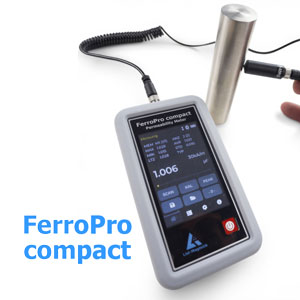A comparison of permeability and remanence in material testing
Magnetic permeability should not be confused with remanence or residual magnetism. Remanence indicates the strength of an object's magnetization, while permeability indicates how easily an object can be magnetized. These values are both important parameters in material testing, especially in testing ferromagnetic materials, and they play a decisive role in selecting suitable magnetic field measuring devices, such as gaussmeters, teslameters, and magnetometers.
Importance of permeability in materials testing
The relative permeability (µr) parameter indicates the extent to which a material can be magnetized. This value is particularly important in stainless steels, which are not actually desired for their magnetism. Another term for this is magnetic conductivity. This concept is particularly relevant in materials technology, material analysis, and non-destructive testing of materials.
This is a decisive factor in magnetic field measurement and the analysis of magnetic field strength, also in the context of material testing NDT (non-destructive testing). There is no unit of measurement, µr is dimensionless. Simple magnetic field sensors and magnetic field measuring systems work in a range from µr = 1 to 5. Modern digital gaussmeters and specially developed magnetic field sensors are used for these measurements. These enable precise magnetic field analyses including magnetic field line analysis and allow the magnetic field intensity to be determined.

Magnetic field measurement in industrial material testing
Magnetic field measurement solutions and test methods are becoming more prevalent in industrial applications. In addition to determining permeability, they enable the measurement of magnetic flux density and magnetic field lines. These methods are an essential part of modern materials testing using NDT and classic non-destructive testing.
These measurement methods are essential for sensitive applications such as sensor production, electric motor manufacturing, and medical technology because the highest level of accuracy is required.
Remanence or residual magnetism
Remanence is the magnetization that remains in a material after an external magnetic field is removed or the material is demagnetized. This property is important in both destructive and ferromagnetic material testing, especially for safety-critical components.
When taking magnetic field measurements, keep in mind that the Earth's natural magnetic field can affect the results. Although this field is very weak at 0.2 A/cm, it can increase or decrease the measured value depending on the probe's orientation. Deviations of up to 10% are possible due to these influences. Therefore, it is crucial to have reproducible conditions for object and probe positioning to obtain meaningful results. The positions of both the object and the measuring probe must be considered.

To minimize such influences, precise magnetic field measuring devices such as gaussmeters, teslameters, magnetometers, and digital gaussmeters are used. These devices use modern magnetic field sensors and are part of complex magnetic field measurement systems specially developed for magnetic field measurement, analysis, and line analysis, as well as for measuring intensity and flux density.
These magnetic field testing methods are primarily used for industrial magnetic field measurements. In Germany, there is an increasing demand for high-quality magnetic field measuring devices. Various magnetic measurement methods improve the accuracy and reproducibility of magnetic field measurement solutions. Today, these systems are closely linked to other testing methods, such as ultrasonic material testing and material thickness measurement, to gain in-depth insights into the quality and integrity of materials.
Quality and precision from List-Magnetik
List-Magnetik's measuring devices are "Made in Germany" and combine quality, durability, and precision. They are an integral part of numerous testing processes, ranging from simple to complex. The right measuring technology reliably evaluates and documents material properties.











